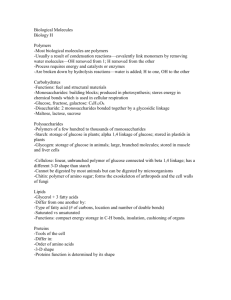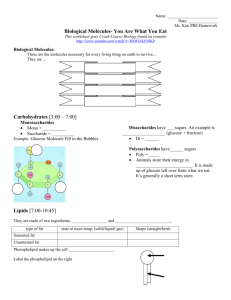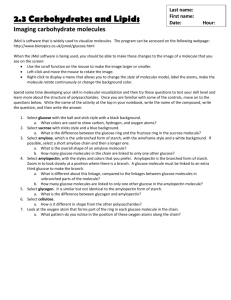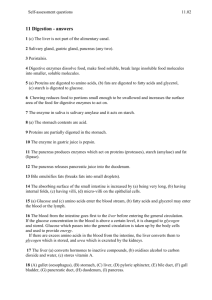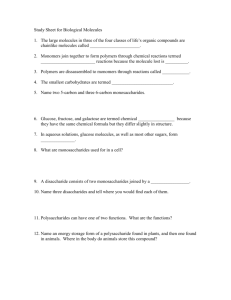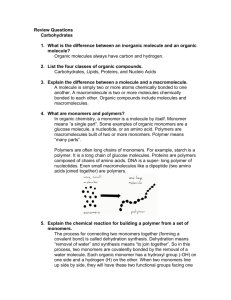Molecules of Life Note Taking Guide (carbs, lipids
advertisement
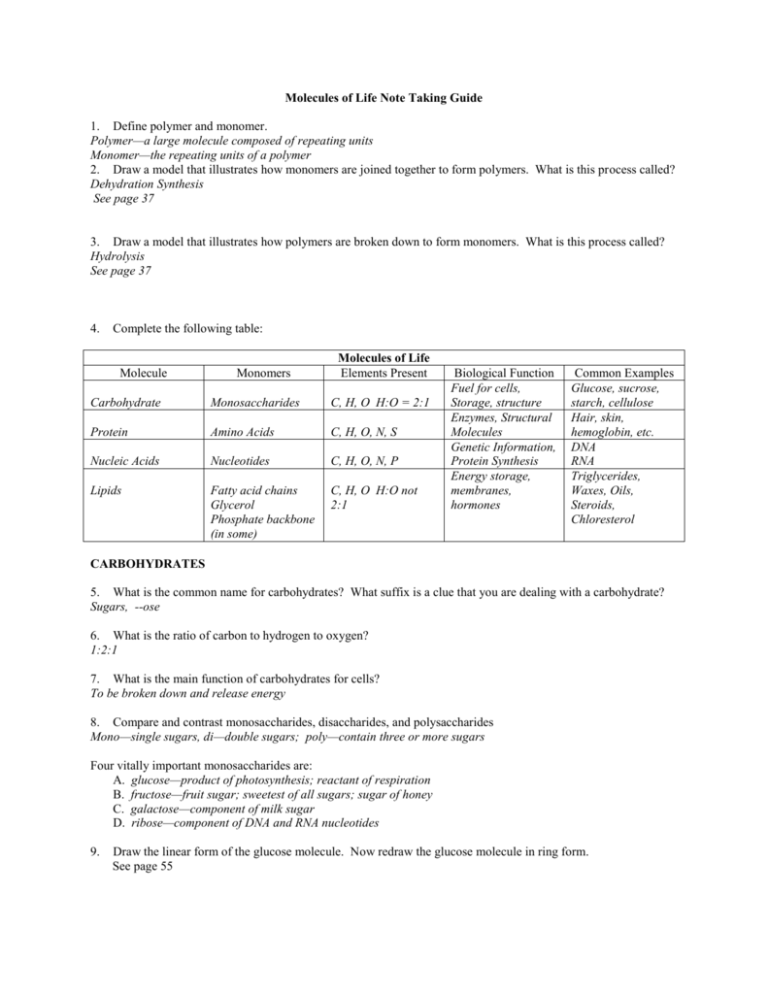
Molecules of Life Note Taking Guide 1. Define polymer and monomer. Polymer—a large molecule composed of repeating units Monomer—the repeating units of a polymer 2. Draw a model that illustrates how monomers are joined together to form polymers. What is this process called? Dehydration Synthesis See page 37 3. Draw a model that illustrates how polymers are broken down to form monomers. What is this process called? Hydrolysis See page 37 4. Complete the following table: Molecule Monomers Molecules of Life Elements Present Carbohydrate Monosaccharides C, H, O H:O = 2:1 Protein Amino Acids C, H, O, N, S Nucleic Acids Nucleotides C, H, O, N, P Lipids Fatty acid chains Glycerol Phosphate backbone (in some) C, H, O H:O not 2:1 Biological Function Fuel for cells, Storage, structure Enzymes, Structural Molecules Genetic Information, Protein Synthesis Energy storage, membranes, hormones Common Examples Glucose, sucrose, starch, cellulose Hair, skin, hemoglobin, etc. DNA RNA Triglycerides, Waxes, Oils, Steroids, Chloresterol CARBOHYDRATES 5. What is the common name for carbohydrates? What suffix is a clue that you are dealing with a carbohydrate? Sugars, --ose 6. What is the ratio of carbon to hydrogen to oxygen? 1:2:1 7. What is the main function of carbohydrates for cells? To be broken down and release energy 8. Compare and contrast monosaccharides, disaccharides, and polysaccharides Mono—single sugars, di—double sugars; poly—contain three or more sugars Four vitally important monosaccharides are: A. glucose—product of photosynthesis; reactant of respiration B. fructose—fruit sugar; sweetest of all sugars; sugar of honey C. galactose—component of milk sugar D. ribose—component of DNA and RNA nucleotides 9. Draw the linear form of the glucose molecule. Now redraw the glucose molecule in ring form. See page 55 10. Draw galactose and fructose. Explain why they are isomers of each other and of glucose. Highlight and label a carbonyl group. Highlight and label a hydroxyl group. Which of the two is a ketone? Which of the two is an aldehyde? They are isomers because they have the same molecular formula but different structural formulas. Fructose is a ketone and galactose is an aldehyde. See page 56 for drawings. 11. Monosaccharides, especially glucose, are the source of energy for cellular work. In addition, the carbon skeletons of monosaccharides provide the raw materials for building other organic molecules like amino acids and fatty acids. 12. Name three common disaccharides and describe where they are commonly found. A. sucrose—glucose + fructose—sugar that is transported by plants—sugar cane B. maltose—glucose + glucose—sugar found in corn syrup, malt & germinating seeds C. lactose—glucose + galactose—sugar found in milk 13. Draw the ring form of glucose and fructose. Illustrate how they are joined to form sucrose. See page 57 14. Polysaccharides perform two major functions for cells. They are: A. Energy storage B. Structural molecules 15. In what ways do polysaccharides differ from the smaller carbohydrates? They are insoluble in water; they are not sweet 16. Using a potato plant as an example, explain how starch is formed. Glucose is formed in the leaves, it is then linked together to form starch and stored in the tuber (potato) 17. Draw the ring structure of 4 glucose molecules. Illustrate how they are bonded to form starch. See page 58 18. While plants store their excess glucose in the form of starch, animals store it in a different form. What is it? Where is it generally found in humans? Glycogen, found in muscle and liver cells 19. The most abundant organic compound on earth is a structural polysaccharide produced by plants. Name it. Cellulose 20. Draw the ring structure of 4 glucose molecules. Illustrate how they are bonded to form starch. See page 58 21. Explain how the structure of cellulose makes it such a strong building material. It forms a straight chain. and the fiber formation can be very strong and quite resistant to metabolic breakdown. 22. Even though starch and cellulose and chemically similar, humans can digest starch but not cellulose. Explain why this is true. The enzymes that break the alpha linkage will not break the beta linkage 23. Where is the polysaccharide chitin commonly found? Exoskeleton on arthropods; fungal cell walls 24. What is the most significant molecular difference between the monomers of chitin and the monomers of starch, glycogen, and cellulose? It contains nitrogen Lipids 1. Lipids are not technically polymers. They vary greatly in structure & function. What trait unites all lipids and what structural characteristic accounts for this property? They have long hydrocarbon chains 2. Name the three most biologically important families of lipids. A. fats B. phospholipids C. steroids 3. Fats are known as triglycerides or triacylglycerols. Describe the chemical composition of a fat. A glycerol molecule that is bonded to three fatty acid molecules 4. Use the chart below to compare and contrast (include a diagram!) of saturated and unsaturated fats. Saturated Fats No double bonds Straight Solid at room temperature Animal Fat See page 54 for Drawings Unsaturated Fats At least one double bond Bent Liquid at Room Temperature Fish and plant fat See page 54 for Drawings 5. A diet rich in saturated fats can lead to cardiovascular disease. Why do we need fats at all? Compact reservoir of energy; insulation and cushion for vital organs 6. How is the structure of a phospholipid molecule different from that of a triglyceride molecule? Has only 2 hydrocarbon (fatty acid) chains; attached to a phosphate molecule and glycerol 7. Describe how phospholipids behave when they are in contact with water. Why is this such a great adaptation for the structural molecules of plasma membranes? Hydrophobic tails; hydrophilic heads The C-H bonds are very nonpolar so they are not water soluble (hydrophobic) which makes them turn toward each other to form a membrane. See page 53 8. Draw the characteristic structure of a steroid. See page 53 9. Cholesterol is a vital steroid. Explain its critical importance to vertebrates. Structural component of cell membranes; precursor molecule for many hormones NUCLEIC ACIDS 1. Name the two nucleic acids. DNA and RNA 2. What critical life role is accomplished by nucleic acids? Storage and transmission of the genetic code; synthesis of proteins 3. The monomers of nucleic acids are called nucleotides. The 3 parts of the monomers are A. phosphate group B. a pentose sugar C. nitrogen base 4. What role do hydrogen bonds play in the DNA molecule? Hold the two strands of the molecule together


